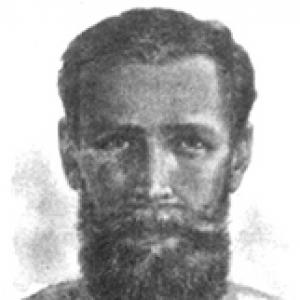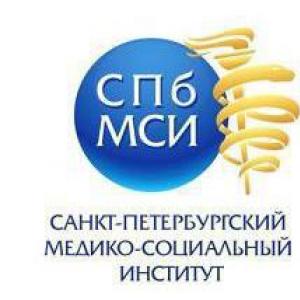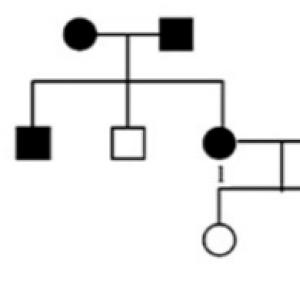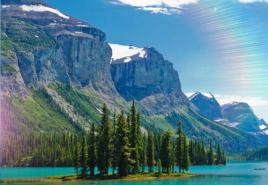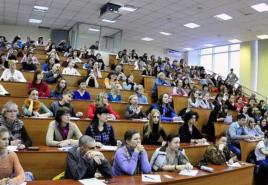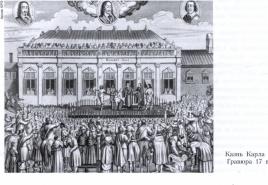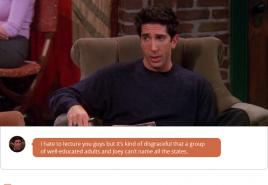Топик "Кремль" (Moscow Kremlin). Описание кремля Небольшое сообщение по английскому языку про кремль
The Moscow Kremlin was built in 1482-1495. It is situated on the high left bank of the Moskva River, where the river Neglinnaya flows into it.
Just as the White House in Washington, the Kremlin in Moscow is the official residence of the President of the Russian Federation.
If you look at the Kremlin"s plan, you will see that it is an irregular triangle with the area of 27.5 hectares.
From the south of the Kremlin there is the Moskva River, in the northwest there is Alexander Gardens, and in the east there is Red Square.
The present red walls and towers of the Kremlin were built in 1485-1516. At the top the wall is decorated with the teeth in the form of a swallow"s tail. On the outer side the wall is smooth and the inner side of the wall is framed with arched recesses for reinforcement and facilitating the construction. In the Kremlin there are five palaces and four cathedrals.
Along the walls there are twenty towers. The tallest tower is the Troitskaya Tower. New Year is traditionally greeted by the Russians with the chimes of the Spasskaya Tower.
Московский Кремль был построен в 1482-1495 годах. Он расположен на высоком левом берегу Москвы-реки, где в нее впадает река Неглинная.
Как Белый дом в Вашингтоне, Кремль в Москве – это официальная резиденция Президента Российской Федерации.
Если посмотреть на план Кремля, то мы увидим, что он представляет собой неправильный треугольник площадью 27,5 га.
С юга от Кремля протекает Москва-река, на северо-западе находится Александровский сад, а на востоке – Красная площадь.
Настоящие красные стены и башни Кремля были построены в 1485-1516 годах. Сверху стена украшена зубцами в форме хвоста ласточки. С внешней стороны стена гладкая, а с внутренней стороны оформлена арочными нишами для упрочнения и облегчения конструкции. На территории Кремля расположено пять дворцов, четыре собора.
Вдоль стены расположено двадцать башен. Самая высокая – Троицкая башня. Новый год россияне по традиции встречают с боем курантов на Спасской башне.
The Kremlin is the heart of Moscow. It is the oldest historical and architectual centre of Moscow.
First it was a wooden fort. Under Dmitry Donskoy the Kremlin was built of white stone. In 1474 Ivan III sent a mission to Italy to find the best architectural and engineering talent available. They brought back with them Rodolfo Aristotel Fiorovanti of Bologna who was at once an architect, an engineer, an expert in military fortifications.
The Italians introduced a new concept of the fortress wall, quite different in character from that of the old Russian whitestone Kremlins. The walls of Moscow Kremlin were built of red stone.
The Kremlin consists of 20 towers. Four of them are gate towers, the most remarkable of them is the Spasskaja Tower.
The Assumption Cathedral in Kremlin was built in 1475-1479. The Russian Tzars and Emperors were crowned here. The Archangel Cathedral was the burial place of the Russian Tzars. The Annuciation Сathedral was erected in 1484. It is famous for the icons painted by Andrey Rublev and his apprentices.
Ivan the Great Bell Tower, one of the most remarkable structures of the sixteenth century, rises in the centre of the Kremlin. It unites all the Kremlin Cathedrals into a majestic ensemble.
On the stone pedestal at the foot of the Bell Tower stands a Tzar-Bell - the largest bell in the world. Not far from it one can see a Tzar-Cannon.
Another fine example of Russian architecture is the Faceted Palace. It was built in 1487-1491.
One of the well-known Kremlin museums is the Armoury Chamber. It was built in 1851. The famous golden cap of Monomach, the first russian imperial crown of Catherin II, made of guilt silver and many other precious historical items are exhibited there.

Топик "Кремль" (Moscow Kremlin) - 4.6 out of 5 based on 58 votes
]The Kremlin is the symbol of first Russian and later Soviet power and authority. Its crenellated red brick walls and 20 towers were built at the end of the 15th century, when a host of Italian builders arrived in Moscow at the invitation of Ivan III the Great. Of the most important towers, the Saviour (Spasskaya) Tower leading to Red Square was built in 1491 by Pietro Solario, who designed most of the main towers; its belfry was added in 1624-25. The chimes of its clock are broadcast by radio as a time signal to the whole nation. Also on the Red Square front is the St. Nicholas (Nikolskaya) Tower, built originally in 1491 and rebuilt in 1806. The two other principal gate towers--the Trinity (Troitskaya) Tower, with a bridge and outer barbican (the Kutafya Tower), and the Borovitskaya Tower--lie on the western wall.
Within the Kremlin walls is one of the most striking and beautiful architectural ensembles in the world: a combination of churches and palaces, which are open to the public and are among the city"s most popular tourist attractions, and the highest offices of the state, which are surrounded by strict security. Around the central Cathedral Square (Sobornaya Ploshchad) are grouped three magnificent cathedrals, superb examples of Russian church architecture at its height in the late 15th and early 16th centuries. These and the other churches in the Kremlin ceased functioning as places of worship after the Revolution and are now museums. The white stone Cathedral of the Assumption (Uspensky Sobor) is the oldest, built in 1475-79 in the Italianate-Byzantine style. Its pure, simple, and beautifully proportioned lines and elegant arches are crowned by five golden domes. The Orthodox metropolitans and patriarchs of the 14th to the 18th century are buried there. Across the square is the Cathedral of the Annunciation (Blagoveshchensky Sobor), built in 1484-89 by craftsmen from Pskov; though burned in 1547, it was rebuilt in 1562-64. Its cluster of chapels is topped by golden roofs and domes. Inside are a number of early 15th-century icons attributed to Theophanes the Greek and to Andrey Rublyov, considered by many to be the greatest of all Russian icon painters. The third cathedral, the Archangel (Arkhangelsky), was rebuilt in 1505-08; in it are buried the princes of Moscow and tsars of Russia (except Boris Godunov) up to the founding of St. Petersburg.
Just off the square stands the splendid, soaring white bell tower of Ivan the Great; built in the 16th century and damaged in 1812, it was restored a few years later. At its foot is the enormous Tsar Bell (Tsar-Kolokol), cast in 1733-35 but never rung. Nearby is the Tsar Cannon (Tsar-Pushka), cast in 1586. Beside the gun are located the mid-17th-century Cathedral of the Twelve Apostles (Sobor Dvenadtsati Apostolov) and the adjoining Patriarchal Palace.
On the west of Cathedral Square is a group of palaces of various periods; the Palace of Facets (Granovitaya Palata)--so called from the exterior finish of faceted, white stone squares--was built in 1487-91. Behind it is the Terem Palace of 1635-36, which incorporates several older churches, including the Resurrection of Lazarus (Voskreseniye Lazarya), dating from 1393. Both became part of the Kremlin Great Palace, built as a royal residence in 1838-49 and formerly used for sessions of the Supreme Soviet of the U.S.S.R.; its long, yellow-washed facade dominates the riverfront. It is connected to the Armoury Palace (Oruzheynaya Palata), built in 1844-51 and now the Armoury Museum, housing a large collection of treasures of the tsars. Along the northeast wall of the Kremlin are the Arsenal (1702-36), the former Senate building (1776-88), and the School for Red Commanders (1932-34). The only other Soviet-period building within the Kremlin is the Palace of Congresses (1960-61), with a vast auditorium used for political gatherings and as a theatre.
Перевод текста: The Kremlin
Кремль - символ первого русского языка и более поздней советской власти и власти. Его зубчатые красные кирпичные стены и 20 башен были построены в конце 15-ого столетия, когда хозяин итальянских строителей прибыл в Москву в приглашении Ивана III Великое. Из самых важных башен, Спаситель (Spasskaya) Башня, приводящая к Красной площади была построена в 1491 Пьетро Соларио, который проектировал большинство главных башен; его колокольня была добавлена в 1624-25. Перезвоны его часов переданы по радио как сигнал времени к целой нации. Также на Красной площади фронт - С-. Николас (Nikolskaya) Башня, построенная первоначально в 1491 и восстановленный в 1806. Две других основных башни ворот - Троица (Troitskaya) Башня, с мостом и внешним барбаканом (Башня Kutafya), и Башня Borovitskaya - лежит на западной стене.
В пределах Кремлевских стен - один из самых поразительных и красивых архитектурных ансамблей в мире: комбинация церквей и дворцов, которые являются открытыми для публики и - среди самых популярных достопримечательностей города, и самых высоких офисов государства, которые окружены строгой безопасностью. Вокруг центрального Квадрата Собора (Sobornaya Ploshchad) сгруппированы три великолепных собора, превосходные примеры российской церковной архитектуры в ее высоте в последних 15-ых и ранних 16-ых столетиях. Они и другие церкви в Кремле прекратили функционировать как храмы после Революции и - теперь музеи. Белый каменный Собор Предположения (Uspensky Sobor) является самым старым, построенным в 1475-79 в Итальянском-византийском стиле. Его чистые, простые, и красиво распределяемые линии и изящные арки коронуются пятью золотыми куполами. Ортодоксальный metropolitans и patriarchs 14-ого к 18-ому столетию похоронены там. Поперек квадрата - Собор Возвещения (Blagoveshchensky Sobor), построенный в 1484-89 мастерами из Пскова; хотя сожжено в 1547, это было восстановлено в 1562-64. Его группа часовен превышена золотыми крышами и куполами. Внутри - множество в начале изображений 15-ого столетия, приписанных Theophanes грек и Андрею Раблиову, которого полагают многие быть самым большим всех российских живописцев изображения. Третий собор, Архангел (Arkhangelsky), был восстановлен в 1505-08; в этом похоронены принцы Москвы и цари России (кроме Бориса Годанова) до основания Санкт-Петербурга.
Только от квадрата выдерживает роскошную, взлетевшую белую колокольню Ивана Великое; построенный в 16-ом столетии и поврежденный в 1812, это было восстановлено несколько лет спустя. В его ноге - огромный Царь Белл (Царь-Kolokol), брошенный в 1733-35, но никогда ступенька. Поблизости - Орудие Царя (Царь-Pushka), брошенный в 1586. Около оружия расположены Собор середины 17-ого столетия этих Двенадцати Апостолов (Собор Двенадтсати Апостолов) и смежный Патриархальный Дворец.
На западе Собора Квадрат - группа дворцов различных периодов; Дворец Аспектов (Granovitaya Palata) - так называемый от внешнего конца граненых, белых каменных площадей - был построен в 1487-91. Позади этого - Дворец Terem 1635-36, который включает несколько старших церквей, включая Восстановление Лазараса (Voskreseniye Lazarya), датируясь от 1393. Оба стали частью Кремлевского Большого Дворца, построенного как королевское место жительства в 1838-49 и прежде использовали для сессий Верховного Совета СССР; его длинный, желто-вымытый фасад доминирует над набережной. Это связано со Дворцом Склада оружия (Oruzheynaya Palata), построено в 1844-51 и теперь Музей Склада оружия, размещение большое собрание сокровищ царей. По северо-восточной стене Кремля - Арсенал (1702-36), прежний Сенат, строящий (1776-88), и Школа для Красных Командующих (1932-34). Единственное другое здание советского периода в пределах Кремля - Дворец Конгрессов (1960-61), с обширной аудиторией, используемой для политических сборов и как театр.
Часто одной из первых ассоциаций, приходящих в голову при слове «Россия», является Кремль. Это одна из самых старейших и знаменитых достопримечательностей страны. Поэтому важно уметь рассказать о нем на английском языке.
Многие туристы, приезжая в Москву, первым же делом стараются попасть на Красную площадь, рядом с которой находится Кремль. Рассказывая про эту достопримечательность иностранцам, желательно устроить настоящую экскурсию. Если рассказ необходимо подготовить для занятия по английскому языку, то можно распечатать соответствующие картинки.
- Начнем рассказ с истории
Свой рассказ можно начать именно с небольшой исторической справки. Здесь можно привести дату строительства, интересные исторические факты, например:
The construction of the Moscow Kremlin as a red-brick stone fortress began in the late 15th century. At that time Ivan III ruled over the united Russian state, and he invited Italian architects to supervise the reconstruction of the Kremlin. The newly-built stronghold was a massive brick wall with 20 towers. It surrounded the most important buildings, the construction of which was continued later. Now the Kremlin is one of the most ancient parts of the city.
Строительство Кремля началось в конце 15-го века. Тогда Русью правил Иван III, который пригласил итальянских архитекторов для строительства Кремля. В итоге была возведена кирпичная стена, имеющая 20 башен. Они окружали самые важные постройки, строительство которых продолжалось позже. Сейчас Кремль – старейшая часть города.
- Поговорим об архитектуре и особенностях Кремля
Можно рассказать о самом названии, особенностях архитектуры, рассказать про башни и основные строения, которые находятся здесь. Может получиться примерно так:
The meaning of the word “Kremlin” is "a fortress, a citadel inside a city", and its name corresponds to its appearance. From a bird"s-eye view the Kremlin looks like an irregular triangle. Each corner has one tower. But the Kremlin is not only a brick wall and imposing towers, it also includes five incredibly magnificent palaces and four cathedrals. The Spasskie Gates are the main entrance to the fortified complex. Cathedral Square and the Cathedral of the Dormition are situated in its heart. For 300 years the coronation of all Russian monarchs took place in the Cathedral of the Dormition.
Само слово Кремль имеет значение «крепость», название соответствует внешнему виду. С высоты птичьего полет, Кремль выглядит как неправильный треугольник. На каждом углу находится башня. Кремль - это не только стена и башни, в него входят пять невероятно красивых дворцов и четыре собора. Спасские ворота представляют собой главный вход. В центральной части достопримечательности находится Соборная площадь и Успенский собор. В течение 300 лет в Успенском соборе происходила коронация царей.
Но Кремль - это не только туристическая достопримечательность. В нем также находятся главные правительственные здания, и этому обязательно нужно уделить внимание.
The Kremlin is also the the seat of the Russian government. The Grand Kremlin Palace is the principal building, and the through-passage to it is located in the Nikolskaya Tower. The complex serves as the residence of the President of the Russian Federation.
Здесь располагаются и различные государственные учреждения. Главным зданием является Большой Кремлевский дворец. Проход к государственным учреждениям осуществляется через Никольские ворота. Здесь находится резиденция президента Российской Федерации.
Рассказ можно дополнить интересными фактами, это сделает его более занимательным.
The Ivan the Great Bell Tower is renowned for once being the tallest building in old Moscow and the tallest belfry in Russia. The Tsar Bell was installed nearby. It is the world’s largest bell and it weighs about 200 tons. The famous Tsar Cannon was constructed in 1586. The tallest tower of the whole Kremlin complex is the the Troitskaya Tower. One of the most popular towers is the Spasskaya Tower. Its senior architect was the famous Pietro Solari. The main Kremlin clock is situated here, and with its chimes the Russians celebrate the New Year.
Колокольня Ивана Великого знаменита тем, что она длительное время являлась самой высокой колокольней на Руси. Рядом был установлен Царь-Колокол. Он считается самым большим колоколом в мире и весит 200 тон. Знаменитая Царь-Пушка была создана в 1586 г. Самой высокой башней является Троицкая башня. Одной из популярнейших башен является Спасская башня. Ее строительство возглавил итальянский архитектор Пьетро Солари. На ней находятся часы, с боем курантов которых россияне встречают Новый год.

